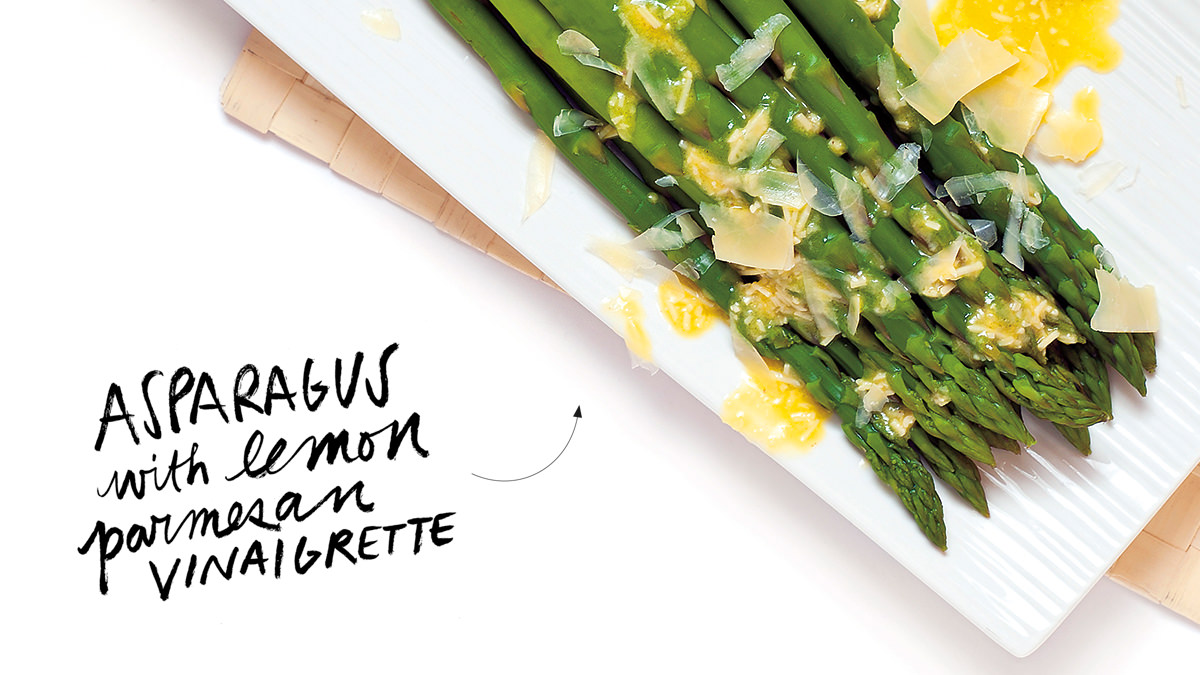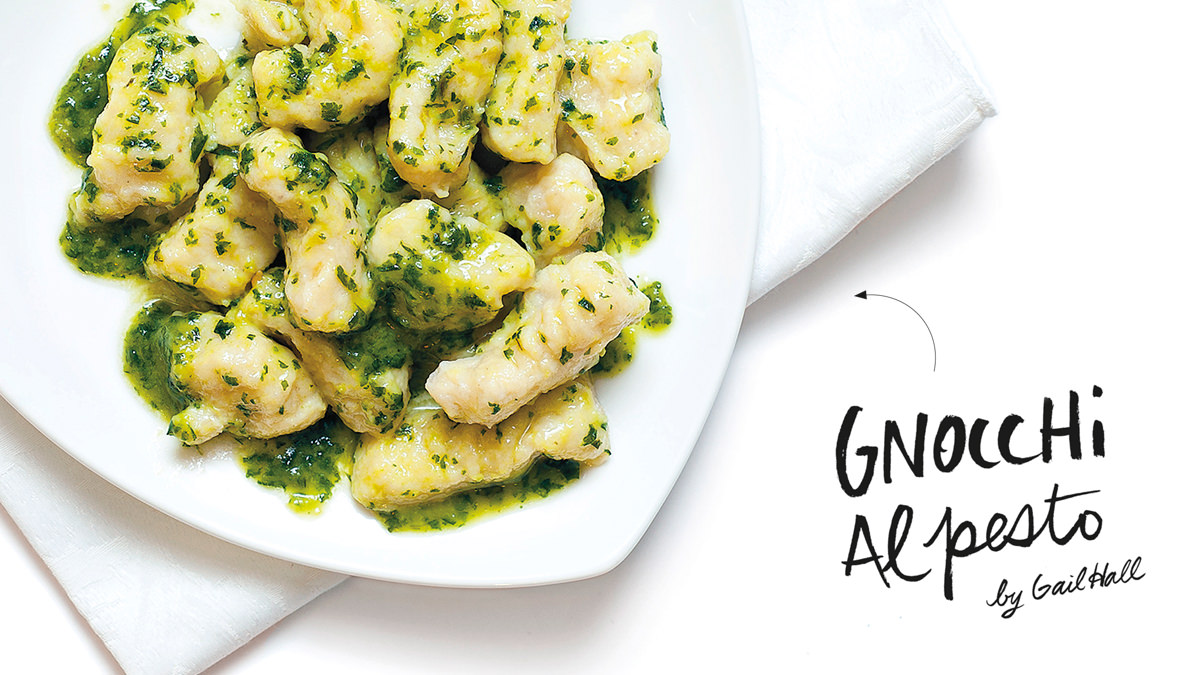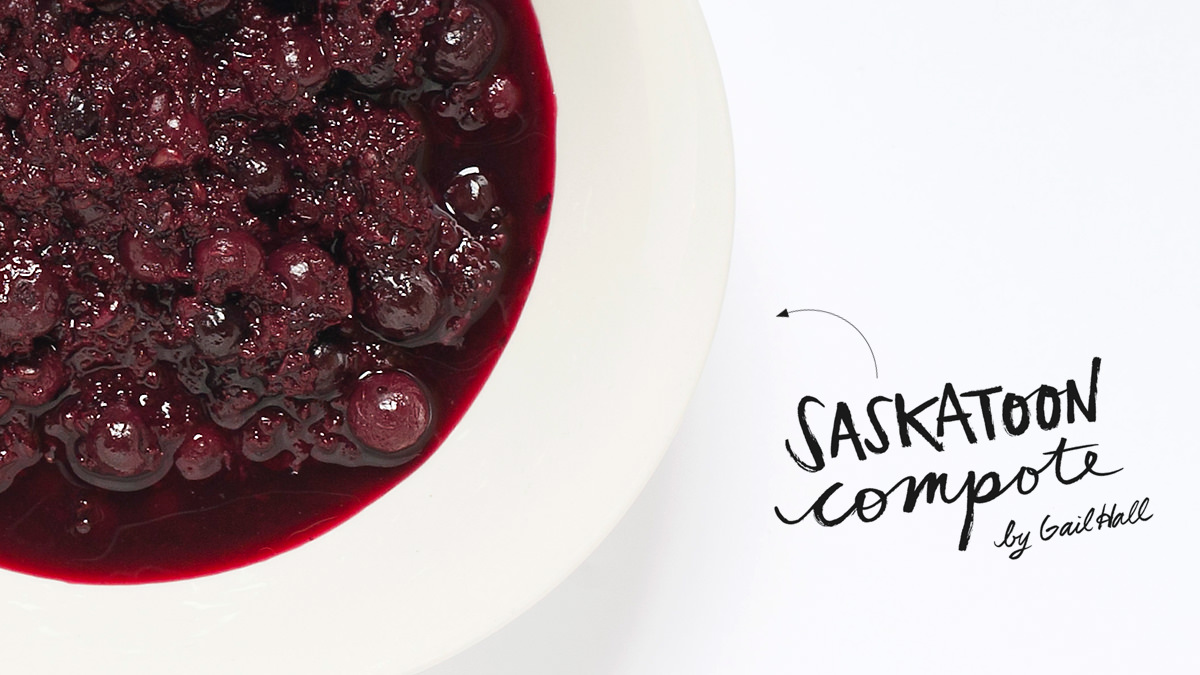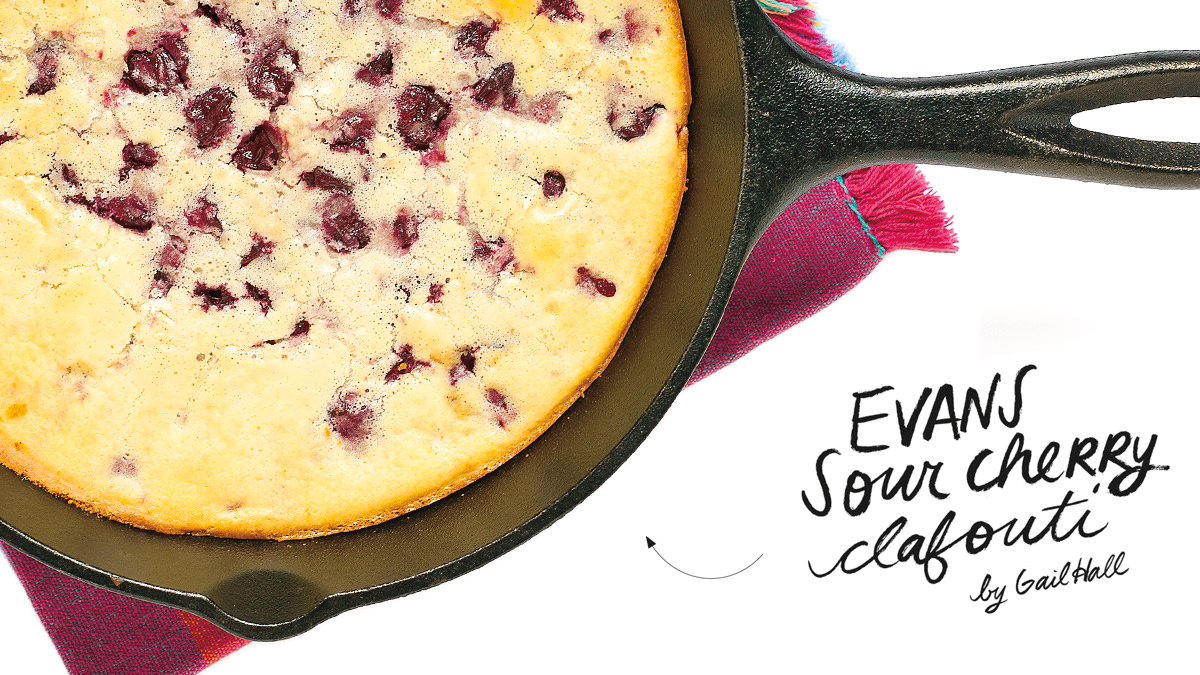By Gail Hall and Cynthia Strawson on May 9, 2014; photography John Ulan
Summer, with its abundance of fresh produce, is the perfect time to eat healthily. We paired nutrition expert Cynthia Strawson, '05 BA, '13 MSc, with chef and food advocate Gail Hall, '85 BA, (seasonedsolutions.ca) to bring you healthy dishes sure to wow at any summer soirée.

- 25 to 30 fresh asparagus spears, ends removed
- 1/4 to 1/2 cup lemon Parmesan vinaigrette
Blanch or steam asparagus. Drain and toss with lemon Parmesan vinaigrette. Serve with shards of Parmesan.
Lemon Parmesan Vinaigrette
Yield: 3/4 cups
- 1/4 cup fresh lemon juice
- 2 to 3 large garlic cloves, peeled
- 2 tablespoons Dijon mustard
- 1/2 cup olive oil
- 1/2 cup fresh, finely grated Parmesan cheese
- salt and pepper to taste
Place lemon juice, garlic and mustard in a blender or food processor. Process on low speed, adding olive oil and blending until smooth. Add Parmesan and blend until slightly thickened. Season with salt and pepper.
Vinaigrette will keep for two weeks in the fridge. If it separates, bring to room temperature and shake well before using.
Serves 6 to 8
Optional: Garnish with 2 tablespoons finely chopped fresh lemon balm.
Summer Guide to Healthy Eating - Asparagus
Peak growing season: May and June in the Prairie provinces; as early as March or April in temperate climates
Why it's healthy: High in vitamins A, C and K, asparagus is also a rich source of folic acid. This makes it the perfect vegetable for healthy skin, eyes, teeth and bones, metabolizing fat and building healthy babies.
Origin: An offshoot of the Liliaceae genus, Asparagus officinalis is native to the eastern Mediterranean but now grows globally, even in Alberta's subarctic continental climate. There are 200 species grown worldwide; three are endangered.
Who'd have thought? Not everyone's pee stinks after eating this mighty green vegetable, nor can everyone smell the asparagusic acid in the urine.
- Cynthia Strawson

- 4 medium to large floury baking potatoes
- 12/3 cups all-purpose flour
- 1 cup Parmesan cheese, grated
- 2 eggs
- 1/2 to 2/3 cups pesto
- salt, pepper and nutmeg, to taste
- grated Parmesan cheese, for garnish
- Wrap potatoes in foil and bake at 375 F until tender. Unwrap and peel the potatoes and pass them through a ricer, food mill or fine grater. Set aside to cool briefly.
- Pour the flour onto a work surface, form a well in the middle and add the cheese and seasonings. Distribute the potatoes evenly over the flour. Add the eggs to the well and heap the flour and potatoes from the outside over top of the well.
- Working from the centre outward, mix the ingredients together with your hands. Knead to a smooth dough, pressing and squeezing with both hands. Do not work the dough longer than necessary.
- Let the dough rest (about 5 minutes) then divide into 4 equal pieces, shaping each piece into a long roll 1-inch to 11/2-inches in diameter. Sprinkle rolls with flour. Cut each roll into 1/2-inch pieces. Using a fork, gently press the top of each gnocchi piece, making grooves in one side to allow the gnocchi to better absorb the sauce. At this point, you can freeze the gnocchi, spacing them on a tray in the freezer. Once frozen, transfer to plastic bags or containers.
- For every serving of gnocchi, bring 2 cups of salted water to a boil. Add gnocchi, reduce heat to a softer boil and cook until they float to the surface. Remove with a slotted spoon into a serving bowl and toss in pesto. Serve immediately with grated Parmesan cheese.
Pesto
Yield: approximately 1 cup
- 1 teaspoon garlic, crushed
- 1/2 teaspoon salt
- 2 cups fresh basil, chopped
- 1/3 cup Parmesan cheese, grated
- 1 cup pine nuts
- 2⁄3 cup olive oil
Combine the garlic, salt, basil, cheese and pine nuts in a food processor. Purée and scrape down sides of bowl until blended well. Add olive oil in a slow, steady stream with processor running. Blend well and serve. Will keep refrigerated for 7 to 10 days or in freezer for up to 6 months.
Serves 8 as entree, 12 side dishes
Summer Guide to Healthy Eating - Potatoes
Peak growing season: July to September
Why it's healthy: Don't avoid spuds because they're a carbohydrate. The magnesium in potatoes actually helps keep blood sugars level and they're as high in fibre as oat bran. Eaten with the skin, potatoes provide twice the potassium of a banana.
Origin: This mighty tuber was domesticated in the Andes 10,000 years ago and was introduced to European palates from South America in 1567. Cultivated potatoes (Solanum tuberosum L.) are a member of the deadly nightshade family along with tomatoes (Solanum lycopersicum) and eggplant (Solanum melongena).
Who'd have thought? Potato kingdoms like Idaho and P.E.I. get many of their seed potatoes from verdant farmland in northeast Edmonton.
- Cynthia Strawson

- 1 cup water
- 1 cup apple juice (preferably organic unfiltered)
- 1/4 cup cider vinegar or 2 tablespoons lemon juice
- 1 tablespoon finely diced shallots
- 2 sprigs fresh rosemary or thyme
- 3 cups saskatoons, washed
- 1 to 2 tablespoons honey (optional)
- In a saucepan, bring all ingredients except honey to a boil; reduce to a simmer until berries are soft (about 20 minutes). If too tart, add honey to taste and stir.
- Purée half the mixture and combine with remaining compote. For a thicker sauce, continue to simmer until desired consistency. Serve warm with sliced beef, bison, turkey, ham, chicken or pork.
Summer Guide to Healthy Eating - Saskatoon Berries
Peak growing season: Ripe in July and August
Why it's healthy: The berries' blue-purple, anthocyanin-rich skin makes them age-fighting, anti-cancer and anti-inflammatory powerhouses. Their high fibre content (six grams per 100 grams of berry) will really move you, too!
Origin: Also known as serviceberry (Amelanchier alnifolia Nutt.), this deciduous shrub is native to the northern prairies and plains of North America and is prolific enough to make the berries a viable commercial crop.
Who'd have thought? Not really a berry at all, saskatoons are actually a pome fruit (Rosaceae) along with apples and pears. They have higher levels of antioxidants than wild blueberries, strawberries and raspberries, and they grow wild and free in Edmonton's river valley.
by Cynthia Strawson

- 2 to 3 cups fresh-pitted Evans cherries*
- 2 tablespoons sugar
- 3/4 cup whole milk
- 3 eggs
- 1 tablespoon amaretto
- 2 tablespoons melted butter
- 3/4 cup all-purpose flour
- 1/4 cup sugar
- 1/2 teaspoon baking powder
- 1/4 teaspoon salt
- 1/2 teaspoon cinnamon
- 1 tablespoon sugar
Distribute cherries in a buttered 10-inch pie plate and sprinkle with 2 tablespoons of sugar. In a small bowl, beat together milk, eggs, amaretto and melted butter. Add flour, sugar, baking powder and salt and beat to a smooth batter. Pour over cherries. Bake at 375 F until golden brown and set in the middle (about 30 minutes). Will puff slightly. Sprinkle with cinnamon and remaining sugar. Let cool for 10 to 15 minutes before cutting into wedges. Serve warm with whipped cream.
*If Evans cherries are not available, substitute fresh, sour, firm, pitted cherries, sliced black plums, apricots or nectarines.
Summer Guide to Healthy Eating - Evans Cherries
Peak growing season: Ripe in August
Why it's healthy: These cherries are tart rather than sweet. However, the sweetness improves as the season progresses. Although nutritional analysis hasn't been done on Evans cherries (yet), their bright red skin suggests they could contain age-fighting antioxidants.
Origin: The trees might have been handed out to settlers in Alaska and then brought to northern Alberta during the gold rush. Most certainly they have European roots.
Who'd have thought? The Evans cherry (Prunus cerasus) was cultivated in the late 1970s, propagated from a cold-tolerant cherry orchard in north Edmonton that had been producing fruit since the 1920s.
- Cynthia Strawson
